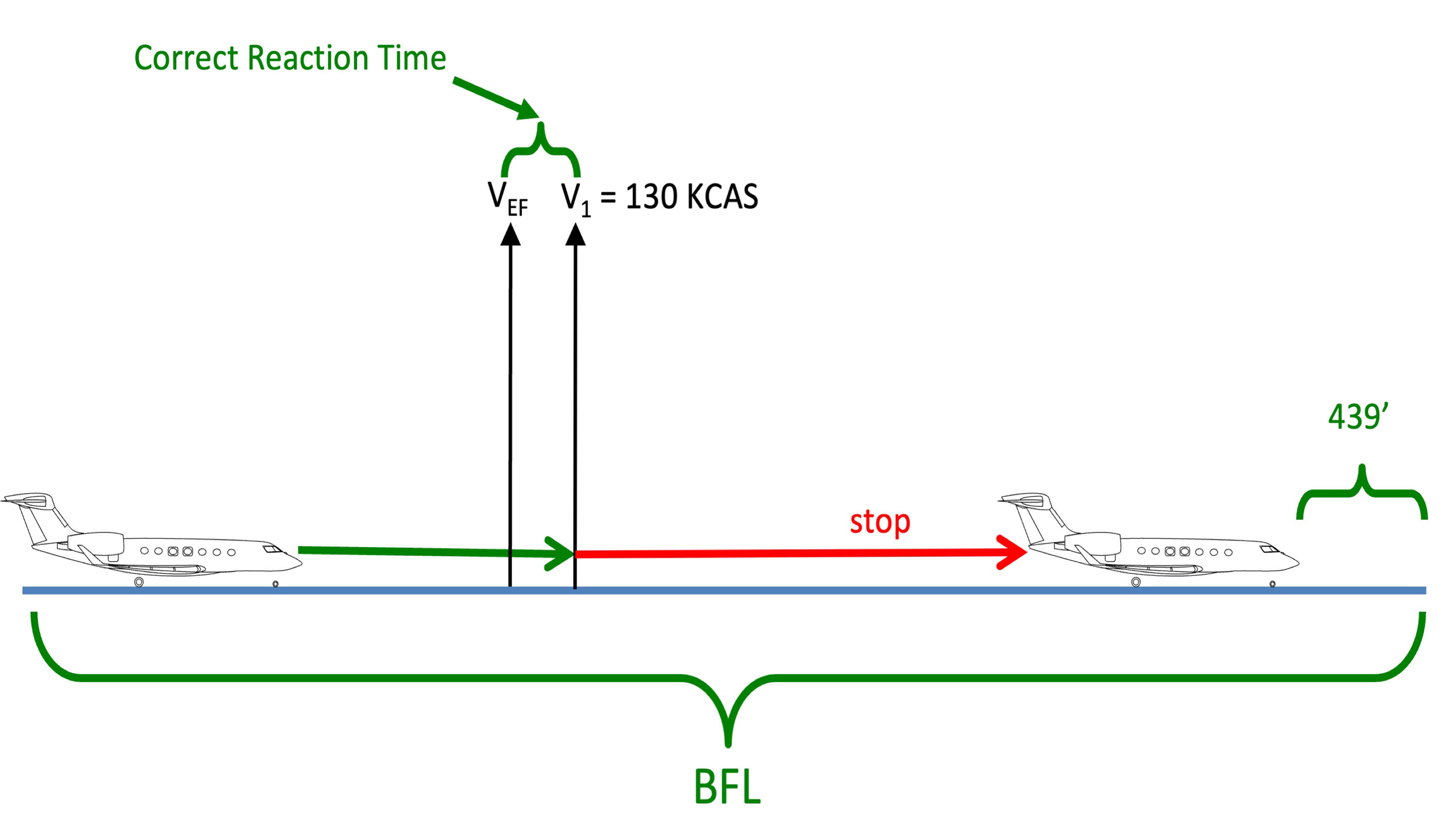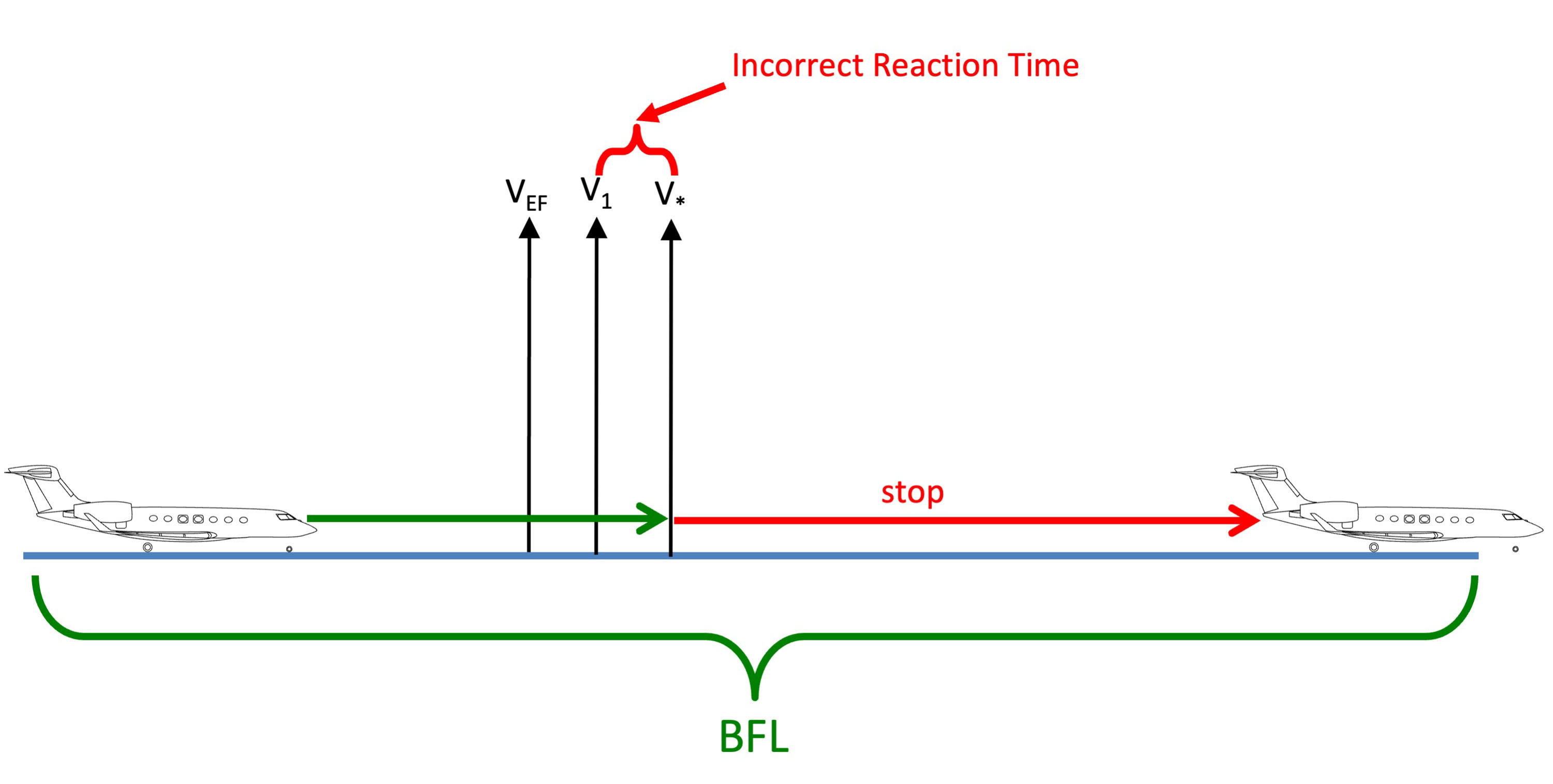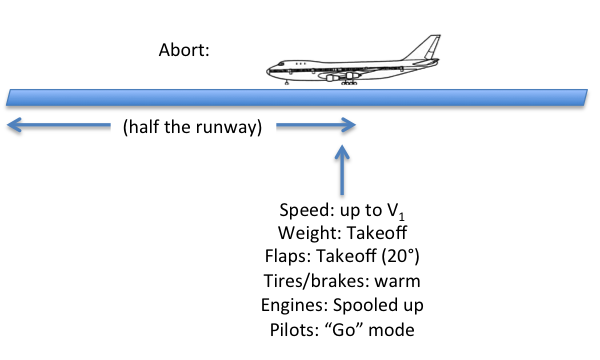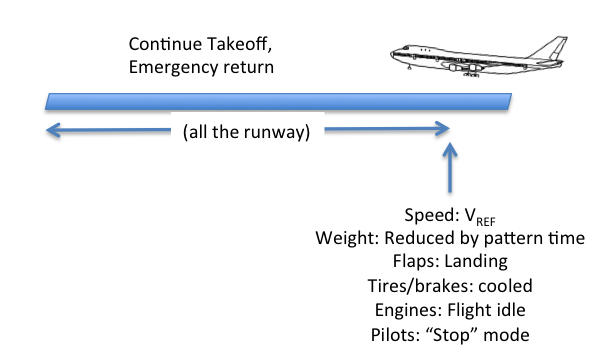What is "decision speed?" Is it the speed where you make a decision? No, it is not. It is surprising how many pilots who should know better get this wrong. The error could kill you.
— James Albright

Updated:
2024-05-15
I was at a G450 recurrent around 2016 or so, when the ground school instructor said this: "There is a two second reaction time built into your V1 speed." Of course this is nonsense but I had promised I would try to stay in "learn mode" and not get into an argument with a recurrent instructor, again. So I let this slide.
A few hours later he asked one of the younger pilots in the class what he would do if he heard the triple chime and saw a stack of red CAS messages at V1. The student said, "I would read them." The instructor said, "Do you have time to read them?" He said, "I have two seconds."
That's when I informed the class, and the instructor, that when you are at V1, the decision to abort or continue has been made. Not only that, the so-called two second reaction time is not true, it varies by manufacturer, and the decision comes after VEF and before V1, not after V1. The instructor argued, I argued back. I showed him the regulations and the aircraft flight manual. He wouldn't budge. During the lunch break I think someone from the staff talked to him and he finally backed down. At the end of the day he apologized. But I think he was doing more so to avoid further trouble, not because he realized he was wrong.
Which training vendor was this? Let me just say it is the one with the "Takeoff Go/No-Go Advanced Training Course."
Part of the confusion among us older pilots may be that the FAA, pre-1998, had a different definition and that allowed manufacturers to come up with their own ideas, such as V1 comes before the action. Those days are gone but if you would like some historical background, see: How it used to be.
6 — V1 philosophy: old school method

1
Regulatory
Multi-engine transport category aircraft are certified so that manufacturers are allowed to pick a V1 "Decision" speed that must be AFTER the critical engine fails at VEF (engine failure speed), and AFTER the interval given for the pilot's recognition and reaction time. V1 comes AFTER all that. U.S. regulations specify a distance for all of this to happen that includes a distance equal to two seconds of the distance traveled at V1 speed that is added to the distance it takes the airplane to come to a complete stop.
V1 means the maximum speed in the takeoff at which the pilot must take the first action (e.g., apply brakes, reduce thrust, deploy speed brakes) to stop the airplane within the accelerate-stop distance. V1 also means the minimum speed in the takeoff, following a failure of the critical engine at VEF, at which the pilot can continue the takeoff and achieve the required height above the takeoff surface within the takeoff distance.
Source: 14 CFR §1.1
Note this is from 14 CFR 1, not the aircraft certification regulation. By definition, the action is in progress at V1.
(a) V1 must be established in relation to VEF as follows:
(1) VEF is the calibrated airspeed at which the critical engine is assumed to fail. VEF must be selected by the applicant, but may not be less than VMCG determined under § 25.149(e).
(2) V1, in terms of calibrated airspeed, is selected by the applicant; however, V1 may not be less than VEF plus the speed gained with critical engine inoperative during the time interval between the instant at which the critical engine is failed, and the instant at which the pilot recognizes and reacts to the engine failure, as indicated by the pilot's initiation of the first action (e.g., applying brakes, reducing thrust, deploying speed brakes) to stop the airplane during accelerate-stop tests.
Source: 14 CFR §25.107
The manufacturer can select V1 so long as it occurs after VEF and the pilot's reaction time.
Accelerate-stop distance.
(a) The accelerate-stop distance on a dry runway is the greater of the following distances:
(1) The sum of the distances necessary to—
(i) Accelerate the airplane from a standing start with all engines operating to VEF for takeoff from a dry runway;
(ii) Allow the airplane to accelerate from VEF to the highest speed reached during the rejected takeoff, assuming the critical engine fails at VEF and the pilot takes the first action to reject the takeoff at the V1 for takeoff from a dry runway; and
(iii) Come to a full stop on a dry runway from the speed reached as prescribed in paragraph (a)(1)(ii) of this section; plus
(iv) A distance equivalent to 2 seconds at the V1 for takeoff from a dry runway.
(2) The sum of the distances necessary to—
(i) Accelerate the airplane from a standing start with all engines operating to the highest speed reached during the rejected takeoff, assuming the pilot takes the first action to reject the takeoff at the V1 for takeoff from a dry runway; and
(ii) With all engines still operating, come to a full stop on dry runway from the speed reached as prescribed in paragraph (a)(2)(i) of this section; plus
(iii) A distance equivalent to 2 seconds at the V1 for takeoff from a dry runway.
Source: 14 CFR §25.109
Regardless of what V1 the manufacturer chooses, the accelerate-stop distance will include a distance based on what would have been traversed during 2 seconds at V1 speed. That doesn't give you two extra seconds, it does give you a safety margin. The fact the distance is computed at V1 speed is important . . .
2
Dynamics
Let's look at a concrete example, and we'll make it an aircraft with good rejected takeoff characteristics, the Gulfstream V:
Under the example conditions, the GV will have a V1 of 130 KCAS. Since this example is at sea level on an ISA day, we'll say KCAS = KTAS and can compute the distance traveled at V1 in two seconds thusly:
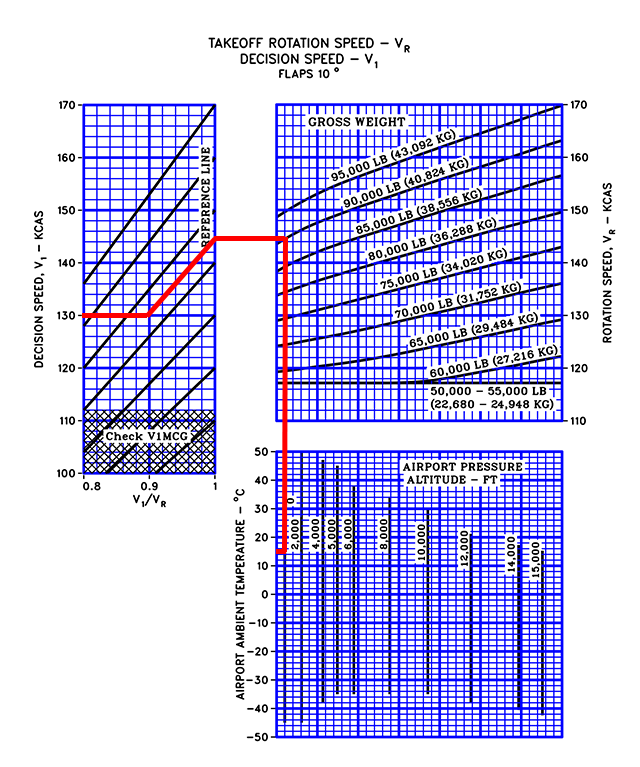
GV Decision Speed Example, from GV AFM, §5.5-7.
Under the example conditions, the GV will come to a complete stop with a margin of 439' to spare. But Gulfstream certified the GV with a 1.25 second reaction time. That doesn't mean you get less of a margin, the abort must still be in progress by the time you get to V1. It just means you have only 1.25 seconds after the engine fails to initiate the abort.
Now let's say you disagree and believe you have two seconds starting at V1. How fast will you be traveling with another two seconds? I've timed it and it tends to average around ten knots more speed. How much distance will you cover?
I've run the numbers for a GV and the runway required comes to 6,000 feet for a 90,000 lb. aircraft at 15°C on a sea level day. Adding 10 knots to the speed at which an abort is begun adds 500' to the abort distance.
Whatever BFL margin you had, it is now behind you.
3
Thermodynamics
Even if you had the necessary distance because the runway available exceeds the balanced field length, that extra two seconds may be more than your manual figured your brakes can take. How much more?
Higher speed means more work for the brakes, right? How much more? The kinetic energy of the aircraft is measured in Joules and to find that, we need the mass of the aircraft in kilograms. A 90,000 lbs GV has a mass of 40,823 KGS. We also need the speed in meters per second. 130 nm/hr comes to 66.75 meters per second:
Our aircraft, at V1 will have this much kinetic energy:
Increasing the speed of brake application by 8 percent (from 130 to 140) means the new velocity figure is:
Our aircraft, at V1 will now have this much kinetic energy:
That extra 2 seconds increased the workload on your brakes by 15 percent!
4
Example aircraft
Now you should understand the reaction time comes before V1. But you should also realized it may not necessarily be two seconds.
So we see that extending the time you start to abort the takeoff by only two seconds means you could exceed the balanced field length safety margins and may add 15 percent to the amount of energy your brakes will have to absorb. So you need to make the decision to abort before V1. Two seconds? It depends. Very few manufacturers actually publish the reaction time used to compute their V1 speeds. Here are a few examples that do. On our example GV, the answer is less:
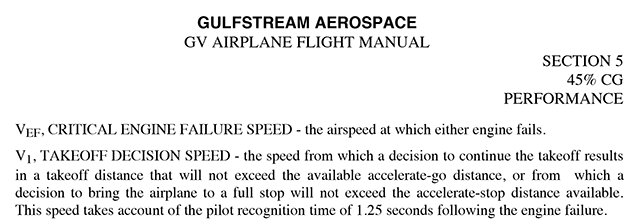
GV Decision Speed Definition, from GV AFM, §5.1-3.
In a GV, you only have 1.25 seconds. Does that carry over to other Gulfstreams?

G450 Decision Speed Definition, from G450 AFM, §05-01-00, page 05-4.
In a G450, you only have 1.0 second.
How it used to be
If you are flying an older aircraft with old manuals you may find other guidance that hasn't kept up with the times. 14 CFR 25, §25.107 read differently before 1998:
V1 must be selected by the applicant and must be at least the minimum calibrated airspeed at which controllability by primary aerodynamic controls alone is shown (during the takeoff run) to be adequate to safely continue the takeoff, using normal piloting skill, when the critical engine is suddenly made inoperative.
Source: 14 CFR 25, §25.107 OUTDATED
That gave the manufacturer a lot of room to invent their own rules. So there are manuals out there that say you get to V1, you have three seconds to decide, and then you have a second or two to act. If you search around the FAA Historical Regulations you will see that the rules were changed to read as they do now about 1998 in an effort to harmonize with EASA.
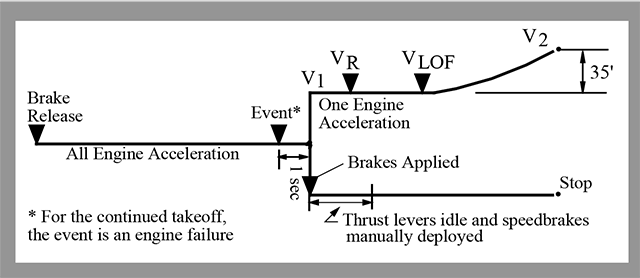
Boeing 737 NG Rejected Takeoff Decision, from B737 NG FCTM, §3.22.
In a Boeing 737 NG, you only have 1.0 second.
5
Operational impact
If you are in the practice of calling "Vee One" at V1, this should change the way you fly airplanes. So when do you call "Vee One?" I have a technique for that.
If you don't know V1 has occurred when you decide to abort, you have made a decision without complete information. The first officer has to have enunciated the words "Vee One" and you must understand them by the time you get to that speed. I've watched this in simulators for many years and now that I am flying an airplane with a Heads Up Display, I've noticed that most pilots seem to start the "Vee One" call at V1. That is too late! Here is a better idea.
First Officer Technique: call V1 so as to have the call completed at V1.
Captain Technique: Once you hear the first syllable of the call, "Vee...", then you are in go mode.
FAA Clarification
The pilot flying cannot react properly to V1 unless the V1 call is made in a timely, crisp, and audible manner. One method of accomplishing this by a major U.S. carrier is their adoption of a policy of "completing the V1 callout by the time the airplane reaches V1.
Source: FAA Takeoff Safety Training Aid, pg. 2-40
The cited FAA Takeoff Safety Training Aid was published in 1993. I learned of this technique while attending the United Airlines Boeing 747 Captain's course in 1986. It seems this technique-turned-procedure came from United . . .
6
V1 philosophy: old school method
In the days of yore – that means anything prior to 1986 for me — the year I learned the error of my earlier training — the days before flying “modern” aircraft – the takeoff abort briefing was short and easy to understand.
“If we have anything go wrong prior to V1 we’ll abort.”
United Airlines, 1986
I went through the United Airlines Boeing 747’s Captain’s course in 1986, just a month after they released the findings of an internal study on high-speed aborts. The study concluded that ninety percent of the high-speed aborts executed by their pilots would have been better handled in the air. Many of those aborts resulted in damage to the aircraft, serious injuries, and even fatalities.
The findings were ground breaking, challenging the mind-set of every pilot at United. The rationale, once explained, made perfect sense.
Aborting the takeoff with half the runway behind you, you are heavy, fast, you don’t have any drag devices out, the engines are spooled up, and your mind-set is “go.” In short, you are ill prepared to stop the aircraft. And the measure of “half the runway” was a pipe dream. The numbers were based on doing everything perfectly and stopping distance was supposed to be better than your initial takeoff performance. You quite often reached V1 with most of the runway behind you.
If, on the other hand, you took the airplane into the sky, if the airplane was flyable, things got better quickly. You could reduce weight by dumping fuel or simply burning it off. Then when it came down for the emergency return, the airplane could be configured with full flaps, the tires and brakes were cooler, and you would touch down with all the runway in front of you with the engines spooled back ready for reverse thrust.
United mandated a two-tiered abort philosophy: abort for just about anything at a lower speed and only for critical items above that up to V1. I saw the logic immediately and adopted their philosophy as my own. I took that with me back to my Air Force Boeing 747 squadron.
Second Thoughts About the Old School
During my Air Force Boeing 747 checkout I assumed the “you teach, I learn” method and kept the new thoughts to myself. Once checked out, I started to assert my new ideas. The pilots were receptive; the flight engineers were not. Our flight engineers all came from old school Military Airlift Command aircraft: the C-141 and the C-5. They were brought up to be integral parts of the decision process and firmly believed that if they saw the slightest hiccup from the engines they could call “Reject” at V1 minus a tenth of a knot and expect to see the pilots do just that.
After my first modified briefing from the left seat of the aircraft – “above 100 knots I will abort only for an engine failure, aircraft control issue, or fire” – the engineer objected immediately.
“If I say abort,” he declared, “and if you fail to abort, the next thing you are going to see is a crash axe.”
“Would you call abort,” I asked, “for a generator failure at V1?”
“Damned right I would,” he said, “and you better abort when I say abort. I don’t care if you are a captain and I’m just a tech sergeant.”
I agreed to do it his way, but only after insisting on an experiment. “When you call V1, how much runway do you think we are going to have left?”
“Half,” he said, reasoning that at V1 the airplane could either takeoff or abort. Of course that wasn’t true. It takes much more runway to accelerate from zero to V1 than to decelerate from V1 to zero. His error was understandable. As a pilot, my eyes were outside for every takeoff. His would be glued on the engine instruments and airspeed indicator.
“And we can stop comfortably at that point?” I asked.
“Yes,” he agreed, “but you have to apply full braking and full reverse. Immediately.”
“So with less than half the runway it is going to be an iffy stop?”
“Yeah,” he agreed, “that’s why these numbers are so important.”
“So then,” I finished, “when you call V1 today, I want you to instantly look outside and look at the next runway distance remaining marker. Memorize that and we can talk about this more once we level off.”
He agreed. Many large airplane runways have black distance remaining markers on either side. Today’s runway was just over 10,000 feet long, so on either side would be signs from “10” to “1,” counting down the distance from 10,000 down to 1,000 feet remaining. The engineer was counting on looking up and seeing the number “5” after announcing V1.
We were heavy and executed the takeoff perfectly. I knew the answer before he announced it. “Three,” he said, “and I just barely caught sight of it.”
“So,” I said, “we would have to stop an 800,000 pound airplane with the engines at takeoff thrust, the flaps at takeoff position providing very little drag, the brakes heated from a long taxi, and all of that with three or four thousand feet remaining? All that because one generator of eight goes off line?”
He agreed that maybe we would be better off flying the airplane. He took his lesson to the engineer’s union and pretty soon we were doing things the United Airlines way.
7
V1 philosophy: today’s approved solution
From the days of yore – circa 1985 and prior – to today, almost everyone has adopted the two-tiered abort methodology. Most brief, “I’ll abort for anything prior to ____, and above that only for an engine failure or something else we don’t want to take airborne.” The “____” was left to the aircraft type and operator’s preference. It was 100 knots in our Boeing 747 squadron but usually 80 knots everyplace else I’ve been.
“I would abort for anything”
When I started flying the Gulfstream III most briefings started, “Below 80 knots we’ll abort for anything, above 80 knots and prior to V1 we’ll abort for an engine failure or any red master warning light.”
I adopted the mantra until one day looking at the master warning panel. Back then – they’ve since changed it – the top three rows were red and one of those was for “FLIGHT REC FAIL.”
“You will abort for a failed flight recorder?”
Since then I’ve always looked at the “Abort for any red” light or message philosophy with suspicion.
Here are some red warnings in the G450 I would not abort for in the G450 between 80 knots and V1:
- Aft Equipment Hot
- Battery Hot
- Cabin Differential - 9.94
- Cabin Pressure Low
- Fuel Tank Temperature
“Below ___ Knots”
In the Boeing 747 the acceleration was quick, but not so quick as to prevent some reasoned thoughts below 100 knots. You could see a system’s warning or other malfunction, process the information, and make a reasoned go/no-go decision.
The easiest was my very first takeoff in the Boeing 747. United Airlines provided an empty Boeing 747-100 for my check ride. The airplane was between flights in San Francisco and the Air Force was paying for my training and evaluation. United removed all three galleys from the airplane and we only had six people on board an airplane designed to carry more than four hundred. We were light. The takeoff trim system had three stages on warning, depending on the aircraft center of gravity. We were so light the computed trim was outside the warning envelope and even placing the switch at one extreme with the actual trim at the edge produced a warning horn at about 60 knots. I aborted. It was easy.
The Gulfstream V series, including the G450, accelerate so quickly that it is almost impossible to make a reasoned judgment without a few basic rules. Almost everyone briefs “I’ll abort for anything below 80 knots.” I’m not so sure.
If something happens right after brake release and the airplane is doing 30 knots, you have time to glance at the Crew Alerting System and make a decision. At 80 knots on a short runway you may not be so lucky. I do brief, these days, “I’ll abort for anything below 80 knots.” It makes life easier as things get faster.
Above 80 Knots, Below V1
Above 80 knots things happen very fast in the Gulfstream world. The time between 80 knots and V1 can be just a few seconds. The list of things you are better off aborting for at these speeds is very short:
- Engine failure, not producing thrust
- Engine fire, still producing thrust
- Cabin fire
- Controllability issues, including thrust reverser deployment
- Aircraft damage preventing controlled flight
If the failed engine is not producing thrust all of your planning assumptions become invalid. You don’t know if you can further accelerate and make it into the sky. You don’t know if you can clear the obstacle. This one is, and always has been, obvious.
If the failed engine is still producing thrust things get murkier. If it is on fire, however, the question of putting the fire out becomes controlling. Better to keep the thing on the ground and let the fire department deal with it. Their fire extinguishers are bigger than yours.
Cabin fire? The rule is if you can’t put the fire out in eight minutes you probably won’t. It takes eight minutes to takeoff and land in the best of circumstances. What if the cockpit fills with smoke for an unknown reason? Abort.
A deployed thrust reverser calls into question performance numbers as well as controllability. If the airplane isn’t handling right on the ground, you don’t know if it will do so in the air. Abort.
That’s it. All these years, I’ve never had to abort between 80 knots and V1.
At V1
I was at a safety symposium once when the learned speaker said, “We train our entire careers to prepare for an engine failure at V1 that never comes. Nobody I’ve ever met has had an engine failure at V1.” After his speech during a break I let him know I've had three.
The first time for me was in the T-38 at Point Mugu, see Duck Soup. The engine went from full after burner to zero thrust in an instant. A fire ball erupted from the engine forward and aft and left no doubt the thing was shelled. Fortunately the remaining engine was more than enough to limp us around the pattern.
The second time was in a KC-135A tanker in Guam, see Know Your Limitations. We went from four engines to three but the airplane was barely capable of climbing. After dumping over 100,000 pounds of fuel we made it back, albeit charred.
The third time was in a Boeing 707 at Love Field leaving heavy maintenance in Dallas, see B-707 V1 Engine Failure. This time the engine was still producing thrust, but all the other indications were heading south.
8
The mindset
My briefing has been pretty much set since the Boeing 747 days, with a tweak here and there:
“This will be a [rated / reduced thrust] takeoff from the [left / right] seat on a [dry / wet / contaminated] runway. If we have any malfunction below 80 knots call abort, if you do, I will. Beyond 80 knots to a V1 speed of ____ knots, if we have a reduction of thrust, directional control, or a fire onboard the aircraft, or any condition where the airplane will not fly, call abort and if you do I will. Once airborne for an emergency return we [can / cannot] return here [visually / off an instrument approach]. If continuing the departure our instructions are to _____.”
Easy enough to say; hard enough to actually execute. To help things, I key off my hand positions and “swing thoughts,” much like in golf.
Below 80 knots.
If you are flying an airplane with a conventional yoke and nose wheel steering tiller, things can be pretty easy. Under the older Gulfstream rules, for example, below 80 knots, your left hand is on the tiller and your right hand is on the power levers. You are sprung loaded to stopping. Note: Gulfstream has since changed the procedure on aircraft with rudder pedal steering to not hold the tiller at all.
With a side stick things change. Below 80 knots your left hand is on the stick and right hand on the power levers. But you are still sprung load to stopping.
The swing thought is: “any problem, abort.”
Between 80 knots and V1.
At this point your left hand is on the yoke or stick and your right is still on the power levers. You are probably taking off. The swing thought is: “evaluate, abort only if you have to.” In a PlaneView cockpit, you will be sorely tempted to abort for a generator failure: screens pop and go blank, instruments get red x’d and there will be some noise. But the airplane is perfectly flyable.
Above V1.
With a yoke, both hands are on the yoke. With a stick, your left hand is on the stick and your right hand is not on the power levers. In either case, you are going. Swing thought: “go.”
References
(Source material)
14 CFR 1, Title 14: Aeronautics and Space, Definitions and Abbreviations, Federal Aviation Administration, Department of Transportation
14 CFR 25, Title 14: Aeronautics and Space, Airworthiness Standards: Transport Category Airplanes, Federal Aviation Administration, Department of Transportation
Gulfstream G450 Airplane Flight Manual, Revision 35, April 18, 2013
Gulfstream GV Airplane Flight Manual, Revision 30, 13 May 2008
FAA Takeoff Safety Training Aid, April 2, 1993
Please note: Gulfstream Aerospace Corporation has no affiliation or connection whatsoever with this website, and Gulfstream does not review, endorse, or approve any of the content included on the site. As a result, Gulfstream is not responsible or liable for your use of any materials or information obtained from this site.
